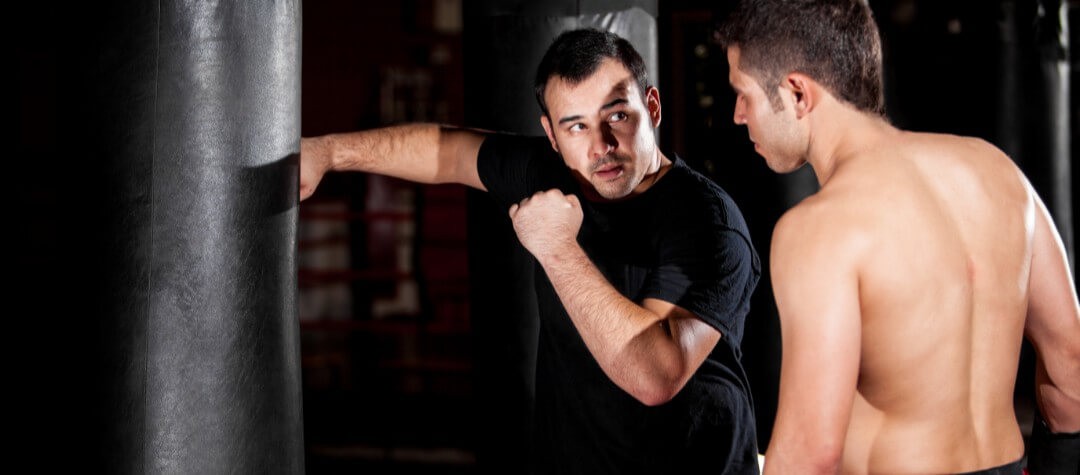Take your boxing up a level with these tactics which will help you combine attack and defense to good effect.
The boxer’s tactics are aimed at making sure they out punch and therefore outscore their opponent. Once the boxer has established a good stance, nimble footwork and a few basic punches, they should start thinking about developing tactics to outsmart their future opponents.
Counter attacking boxing tactics
There are four main punches used in boxing: the jab, the hook, the uppercut and straight punch. These can also be used to come back at the opponent in a counter attack. No boxer can realistically expect to win a fight just by deflecting an opponent’s punches — they should be prepared to hit back too. This is called countering or counter attacking.
Left jab counter
The punch that boxers will face most often is the jab, and from a right-handed boxer this will be the left jab…
-
One good tactic for turning defense into attack is to deflect the opponent’s left jab with the right glove sending it over your left shoulder. A counter left jab should then be delivered to your opponent's chin.
-
Another good ploy is to duck beneath an opponent's left jab and return a left jab to his body.
Straight right counter
A good boxer should never really get caught by a straight right as it is within sight all the way to when it connects.
-
A good form of defense for the beginner is to block the punch by shifting the weight to the back foot and turning the body sharply to the right to catch the punch high on the left shoulder. A counter with straight right should be delivered, while keeping the chin well out of the way.
-
The boxer can sidestep to the left to avoid the punch. And then return a straight right to the opponent.
Fighting in close
A large part of a fight may be won by simply avoiding your opponent’s punches and tiring him out. However, a different tactic could involve boxing at close range or ‘infighting’, almost toe-to-toe with the opponent.
This is a bold approach and takes a lot out of both boxers as it usually involves receiving blows as well as giving them, often in quick succession. If your opponent has a longer reach it's essential to move in close where a wide range of short hooks and uppercuts can be used to cancel out the reach advantage.
Defensive boxing tactics
Good defensive skills are just as important as good attacking skills. A boxer needs to be able to deliver good punches without receiving many in return.
A boxer needs to be agile and have good reflexes to be able to defend himself and stay out of trouble. One way could be to stay out of reach, but that will not score any points.
There are several ways to defend yourself from a punch either by dodging or blocking them:
- Sidestep — literally stepping to the side of the blow.
- Snap back — rocking backwards to avoid the blow connecting.
- Sway to one side — swaying from the hips to avoid the punch.
- Block — stopping the punch with the forearm, shoulder, elbow or glove.
- Duck down — duck out of the way of a punch.
- Parry or deflect to one side — knock the punch aside.
- Cover up — use the arms and gloves to best protect the head and body.
Other boxing techniques...
Breaking away
This is a good tactic to use when fighting up close. The boxer should aim to get in and deliver a quick succession of blows, and then move out to arm’s length before suffering too much damage.
To break away from an infighting situation, the boxer can put their gloves on the opponent’s arms and push themselves backwards, thus preventing the opponent from delivering any punches.
Feinting
A boxer can pretend they are going to hit a part of the body, but then hit a different area. By deceiving the opponent, it is hoped to open up an opportunity to get in a good punch. Feinting requires using all manner of parts of the body parts from the eyes, hands, body, legs, and facial expressions — all intended to trick an opponent about your next move.
A final word about boxing tactics
Boxing requires more than just brute strength; a lot of thought is required to outsmart an opponent. A boxer needs mental toughness to succeed and has to be prepared to both receive punches as well as give them. Very few boxers win a fight through losing their temper.
When it comes to tactics, the boxer needs to try and work out what tactics their opponent is employing and try to find a weakness. It may even be necessary to change tactics part way through a fight if things are not quite going according to plan.














